History of Skyros
The history of Skyros, millenia long and adventurous, is not very different to the one of the Aegean Sea as a whole. Good times and bad times, prosperity and impoverishment, freedom and slavery, heroism and cowardness, not unlike anywhere else in Greece, it is interesting to the travelers wanting to acquire some background knowledge about the place they choose to spend their vacations at.
Prehistoric Era
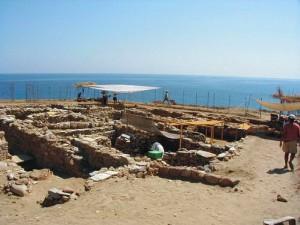 |
|
Excavations at Palamari
|
In Gournes Acropolis and in Ahilli cove remnants of the late Palaeolithic era have been found. Neolithic settlements were found in Tou Papa To Houma and a bit more to the North, in Magazia, while in Pouria there has been an Early Bronze Age settlement. The Early Bronze Age had been a time when the island's economy prospered; its Northern part was densely populated. Settlements were scattered from the eastern slopes of the acropolis as far as Ta Gyrismata, an area roughly identical with the inhabited area of today. Early Bronze Age relics were also found in Atsitsa, Koumari and St. Phokas. In Kartsinoudi, Markessi, Hartza and the Alykos Coves obsidian articrafts found might be proof that there, too, existed such settlements.
A very important discovery was made in the northern side of Palamari Cove, at a place known as Kastraki (Small Castle). Megaron-style houses, with perfectly preserved internal architectural structures dated to the late 3rd and early 2nd millenia B.C., were unearthed. A rich collection of almost intact household items found in deeper layers permit a thorough study of the population's way of life and technical equipment available.
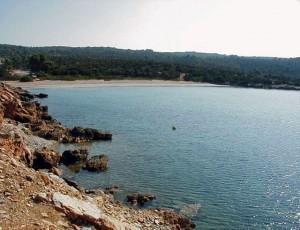 |
|
Skyros: The Beach of Panagia
|
Middle Bronze Age is very difficult to document in Skyros. Some Meso-Helladic “ostraca”, together with Early Bronze Age ones, were found in Tou Papa To Houma, Molos, Polichri, Atsitsa, while in Palamari building traces were identified.
There is no archaeological evidence for the Mycenaean Kingdom of Skyros, although this is well known from the literary tradition and the myths related to it, as well as from the Mycenaean pottery collected from the cemeteries around the acropolis. It is certain that the small settlement on the acropolis hill, as early as the Copper Age, acted as the nucleus for the Mycenaean settlement, and little by little it became the center for all eventual habitation of the island.
Mythical evidence
The first people to inhabit Skyros have been the Thracian Pelasgi, who made their appearance here around 2500-1900 B.C. They, also here, built the Pelasgic (Cyclopean) walls. Pelasgi are known to be present here when the island was occupied by the Athenians in 475 B.C., after their victory over the local Dolopes. But, long before this, Pelasgia, as the island was named after the Pelasgi, was occupied by the Cares, who originated from Asia Minor Caria. Many of the Pelasgi were obliged to flee to Attica and Megaris as refugees. Among them were the ancestors of Theseus, who eventually managed to climb up the social ladder and become part of the Athenian ruling class.
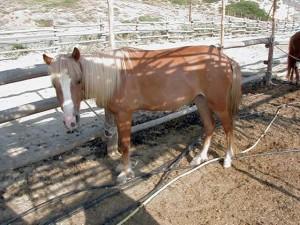 |
|
Ponies of Skyros, 90 cm shoulder height
|
Cares were chased away by the Sovereings of the Aegean, the Cretans, under the leadership of Rodamanthes, who conquered the islands of the Archipelago; the islands were distributed to the Cretan allies and fellow warriors. Peparethos (Skopelos) was offered to Staphylos, and Skyros to Anyeas, son to Dionysus and Ariadne. It was during his rule that all settlements on Skyros were united in one state under his sovereignty. He had the city/castle fortified by strong walls.
During the era of the Minoan Civilization, Skyros made big steps in progress. It was the time that Cretan colonists built Krission in Kalamitsa region. The island's population increased to a level difficult to believe, local enmities ceased, vineyards and olive tree cultivation was well established; Cretans brought along and propagated their advanced Minoan civilization, their religion and their economic system.
After the destruction of the Minoan civilization and the Cretan sea sovereignty declined, around 1540 B.C., Cretans were chased away or subordinated to the new Sovereigns of Greece, Achaeoi, who came to the island crossing the strait from Euboia or the neighboring islands. A group of Achaeoi, named Dolopes, landed Skyros, put it under their rule, and were in control for many centuries. The island was renamed to Dolopia, as we have previously mentioned.
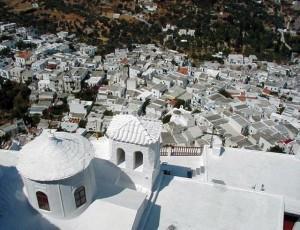 |
|
Skyros Town from the top of the Castle
|
This is the era of Mythological heroes, like Enyeus, Lykomedes, Achilles, Neoptolemos, and Theseus. Skyros was visited by many a renowned kings, respected for their prudence, bravery or even their slyness, like Odysseus, Nestor, Lykomedes, Phoenix, and Diomedes. During the Trojan War, the king of Skyros was Lycomedes, a Dolope descendant, brother of Thetis, Peleus' wife and Achilles' mother. It was here that Achilles spent his youth, had an affair with Deidameia, daughter of Lycomedes' and had a son by her named Neoptolemos. Prophecy said that the son of Thetis would have either a long but dull life, or a glorious but brief one. When the Trojan War broke out, Thetis was anxious and concealed Achilles, disguised as a girl, at the court of Lycomedes, but her trick was revealed by Odysseus, and Achilles, king of Myrmidons, did take part in the war that would mean his death. Achilles sailed to Troja from a small port of the island which was named after him, Achilli (or Ahilli), and it has the same name until today.
Other myths (and more credible ones, one must admit) have it that Dolopes were subordinate to the king of Thessaly, Peleus, but Lycomedes rebelled and tried to gain his autonomy. Achilles, son of Peleus' and his successor, campaigned against him in command of his Myrmidons, defeated him, got control of his castle and killed him. Many prisoners were taken, among whom was Lycomedes' virgin daughter, Iphis, whom Achilles donated as a gift to his friend Patroclus. Homer, in his masterpiece The Iliad, refers to Iphis as the mistress of Patroclus'.
Historical Times
Skyros was colonized by Chalkideans and Athenians. Chalkideans came first, during the 8th and 7th centuries B.C., on their way to their expansion to Macedonia
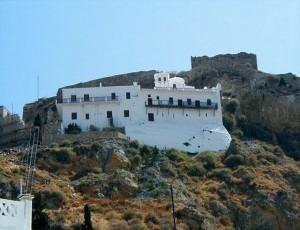 |
|
Saint Georgios Monastery
|
and Thrace. They needed to have their backs safe, so they got control of Skyros and Euboic Kymi.
As a result of the Lelandian war, Dolopes took Skyros again, until they were thrown out by the Athenians. The island was divided into parcels that were given out to Athenians by lottery, making sure in this way that there would always be a vigilant eye for the Athenian interests. It was then that Kimon searched and found the grave of Theseus and brought his bones back to Athens in great honors.
The island imported customs from Athens: Athenian names were given to towns and ports, and Athenian traditional public holidays and manifestations were held here as well. A new city was built on the castle's north side, and the old city was turned into a fortified acropolis. A new small port was built as well, where Skala Agiou Dimitriou exists today.
During the Peloponnesean War, Athenians lost hold of Skyros and the island became autonomous in 404 BC. Later on, the Athenians came back to power, until the city was taken by Syllas, and Skyros became a Roman possession. During the Roman times Skyros remained in the dark. During the pestilence of 165 AD. the island's population was decimated. In 268 AD. Erouloi and Goths plundered Skyros and Lemnos, as well as the eastern coastline of the mainland.
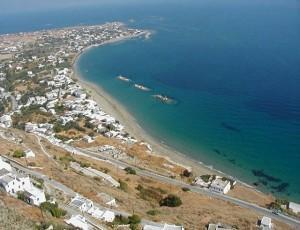 |
|
Skyros Panagia Village and Beach
|
Byzantine Times
During this period Skyros belonged to the Byzantine Empire, and its inhabitants turned Christian. The first Christian community was established at the end of the 2nd century. The first Christians were responsible for the complete destruction of ancient works of Art, temples, altars and statues. This vandalism was much worse than any damage done to the island by all the past plunderers of Skyros taken together! Numerous Christian churches were built at the expense of construction materials taken from ancient Greek public buildings.
During this period Skyros was used by the Byzantine authorities as a place of exile for various public servants who fell into disfavor with high-ranking officials. These people usually spent all their life on Skyros, creating families and bringing wealth and culture to the island. Skyros was safe and in peace for long periods of time encouraging the growth of folk arts: pottery, wood carving, weaving, embroidery, all of which flourished. In 825 Arabs from Andalusia conquered Crete, establishing a big pirate kingdom which plundered the islands and the mainland coasts, and Skyros, together with the rest of the Aegean, underwent material and human damages. Cities were destroyed and their populations decimated, all but the fortified acropolises, difficult to be taken by assault. The Saracens established a lair in Saraceno and inflicted heavy losses and widespread damage to Skyros and the rest of the Aegean islands. This lasted until 961, when Byzantine Emperor Nikiphoros Phokas reconquered Crete, and the pirates were thus deprived of their stronghold.
Medieval Times
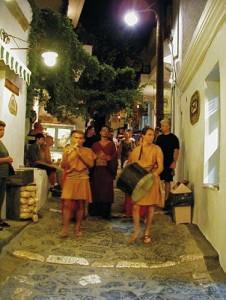 |
|
Skyros Summer Festival
|
After Constantinople's fall to the Frank Crusaders, the Aegean islands were given to the Venetians; conquering them would be impossible to a city of merchants, so Venetian authorities urged individuals to establish Venetian colonies wherever serious profits could be expected. Marco Sanudo set off with a handful of ships with a bunch of fortune-hunting mercenaries on board and managed to conquer 17 islands and establish the Frankish Dukedom of the Aegean, with Naxos as its capital. The Aegean islands were offered as lute to Sanudo's knight fellow fighters and were grouped in timars, under twenty new dynasties. Skyros, together with Skopelos, Alonnissos, Skiathos, Kea, Tinos and Mykonos were given away to the Gizi brothers, Venetian merchants. Long-lasting family quarrels resulted in Skyros becoming a lair of piracy of one of the Gizi brothers' descendants against his kin.
In 1269 Skyros revolted against the Franks and, until 1296, it remained under the rule of Michael Palaeologos, emperor of Byzantium. The island was then taken back by the Franks. Twelve years later, in 1308, the Catalan war fleet, consisting of 60 galleys led by Ferdinand of Majorca, sailed against the islands of the region. After they had attacked, plundered and destroyed Skopelos, they headed towards Skyros, but were met by a sea-storm and all of the ships, but one, sunk with all hands on board, and the island was saved.
The complete destruction of the pirate fleet was due, according to the local people, to a miracle by St. Georgios, savior of the island. It was only the galley of Chief pirate Ferdinand that was saved, but it went ashore to Skyros and, according to the tradition, it was petrified and turned into a huge rock one can still see near Achilli (Ahilli), north of Kochyla.
Later on Dallecarceri, Duke of Naxos, had the island's castle fortified, to fight back attacks by the Genoese and Turks. It was then that the dark dungeon in the castle was turned into the first cistern of the island, to provide the guard with water. More cisterns were built at Tris Boukes port and Kalamitsa, all meant to provide water to the local guard forces.
Between 1400 and 1450 pirate attacks destroyed Skyros. Castles were destroyed to the ground, defending walls were demolished, houses burnt down, many of the island's inhabitants taken away and sold as slaves. The population was heavily decimated and rural regions were deserted. The ones that were spared gathered to two destitute villages, Kastro and Markezina, possibly also Palaeokastro, to lead their miserable lives.
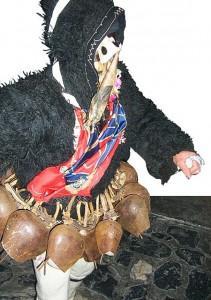 |
|
Skyros Traditional Carnival Costume
|
After the fall of Constantinople in 1453, Skyros was reconquered by the Venetians and, in the 1454 Treaty, their rule was recognized by the Sultan. After the fall of Constantinople the people in the Sporades islands were helpless against the pirates and the Turks, and preferred the Venetian rule, offering themselves and their islands to the Venetian admiral Loredan, on condition they would be allowed to keep their former privileges and the episcopal seat.
In 1470 a great assault of the Turkish admiral Mahmut Pasha against Skyros, on his way to Chalkis, failed.
The Venetians remained in Skyros until 1537. During their rule, there existed some just governors and others, who did not respect the rights of the people of Skyros, and their decisions were blatantly arbitrary.
Turkish Rule
During the late 15th and early 16th centuries the Aegean in particular, but the Atlantic as well, were in the stronghold of the feared pirates, the Barbarossa brothers. One of them, the infamous red-bearded Barbarossa Hayreddin Pasha was so successful that he eventually became a Turkish Admiral and fought many battles in favor of the Ottoman Sultan all over the Mediterranean. He and his ships attacked, massacred, plundered, chained and sold as slaves in the Muslim slave markets the Christian inhabitants of practically all the Aegean islands and coastal towns and villages, not to mention the Mediterranean ones, then under the Venetians. The Sporades Islands were no exception. Although Skyros was ceded to him by treaty, his crew continued with slaughter, plunder and arson. It was the year of 1539. Many of the inhabitants were forced to flee the island and find refuge on Euboia, in Kymi. Most of them returned home when the danger was over.
When the island was finally under the Turks, raids stopped and life could go on without any major catastrophies. The population was purely Greek, and despite the heavy taxation, Skyros could keep its autonomy and self-government.
In 1647, the Venetian fleet of 90 ships under admiral Grimani used Skyros as a lair, waiting for the Turkish fleet to come by. Three years later the Venetian fleet under Leonardo Foscolo attacked the island, conquered the castle, demolished it and killed all the Turkish garrison. They took 11 canons and a lot of Skyrians, who were obliged to serve as oarsmen in their galleys. On the island only old men, women and children were left.
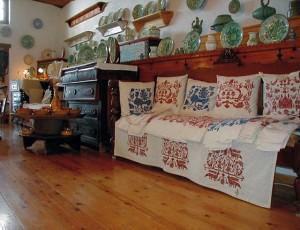 |
|
Skyros Traditional Handicrafts
|
The people had to rebuild the castle, which had served as their safety. It is there that food was kept for the sometimes prolonged sieges and Skyrian families kept their precious belongings. Agriculture should start over, and so did animal husbandry (mainly sheep and goats). Nevertheless, Venetian threat was not over. In 1667, the Venetian admiral Morosini, sailing out from Crete, inflicted a lot of damage to Cyclades and Skyros. It is the same man who bombarded the Athens Parthenon and resulted in its partial destruction and plundering of the artifacts, demolished by the explosion.
In 1770 many Skyrians were taken by force to man the crews of the fleet under the Orlof, the Russian admiral who attacked and inflicted heavy damage to the Turkish armada at Tsesme.
As from 1809, the people of Skyros were obliged to offer a certain number of individuals to serve as sailors in the Turkish navy every year. Very little is known of the existence of a Turkish colony on Skyros: Some foreign traveler's have left written testimony of it; that some Turkish families were established in some villages, that a mosque was built on Skyros, and that there also existed a Turkish cemetery where the Gymnastics grounds of the First Elementary School are today. At the cemetery a tomb stone was unearthed, with an inscription in Arab-Turkish, kept today at the Skyros Archaeological Museum. Whoever
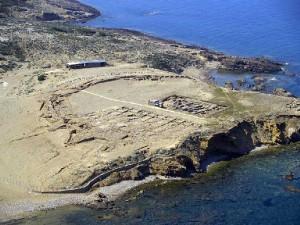 |
|
Skyros Neolithic settlement at Palamari
|
these were, they must have left the island when pirate attacks intensified. Only Ottoman officials were left, the local Governor having also police duties. They had some men in their command, Turkish gendarmes (zaptiehs) and the Judge (The qadi).
After the Turkish-Russian war, these officials also left, with the exception of the qadi. Only short-time visits of Turkish tax collectors with their sentinels were paid. When the Greek Merchant Navy, having hoisted the Russian flag, began to develop, and pay frequent visits to Skyros, also the qadi was withdrawn. Judicial duties were undertaken by three elected elderly men called “Demogerontes”, an institution that flourished during Turkish rule and was abolished by Kapodistrias in 1830. Their superior judicial authority was the Bishop of Syros. Turkish soldiers had no right to set foot on Skyros with the exception of the yearly visit of the Tax-collectors from Constantinople.
A few years before the Greek Revolution against the Turkish rule broke out, this situation gradually changed. Armed rebels coming from Mainland Greece, as far as Macedonia, as well as refugees from nearby Euboia, gathered on Skyros seeking safety. In 1816, five years prior to the uprising, on Skyros there were 760 armed Greeks and Muslim Albanians to which the island offered its hospitality. Those Albanians, known as Liapides, used to serve the Turkish army as mercenaries but, for various reasons, turned anti-Turkish and were welcome to assist the Greek warriors. Because of some not worth mentioning quarrel, the Liapides turned against the defenseless locals, inflicting indescribable harm: looting, arson of most of the island's households, rape and abduction of young girls and women to turn them into slaves. Many Skyrians, not able to cope with such rapacity and atrocity, fled to Psara, Smyrne (Izmir), or elsewhere, only to come back during or after the war of Independence of 1821-1828.
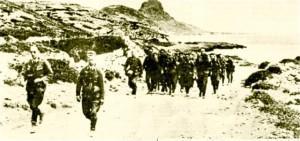 |
|
German army arriving on Skyros
as occupation forces in 1944
|
Skyros, although a small island, contributed to the war substantially, in terms of both money and human life. Skyros always offered refuge to Greek armed warriors, to recover from their wounds and regroup for the continuation of the struggle. Three hundred Albanian mercenaries were hired for the island's protection but another three hundred Greek warriors under various Greek commanders received the island's hospitality.
Modern Times
Skyros gained Freedom together with the rest of The Sporades Islands in 1829 and joined the rest of Greece in good and bad times. Today Skyros has managed to maintain the local cube-like residential architecture, providing in this way an open air museum of building tradition. Folk art and its tradition, wood-carving, ceramics, weaving and needlework, all based on decorative motifs from the local natural and social surrounding, are still alive and continue today. Many other folk traditions are also kept alive, peaked by the Skyrian Carnival Festivities, which remind one of Dionysian worship and the ages-old wish of Man to strengthen the revitalizing forces of Nature. |
|



